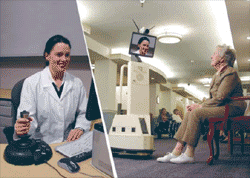We Are the Robots ... and We Want to Take Your Temperature

Consulting with a patient via robot.
Photo courtesy of InTouch Health.
Okay so check it out—the future as sung in part by Kraftwerk is here. Actually it's in the Motor City (my old stomping grounds), where the Detroit Medical Center just became the first hospital system in the world to hire a fleet of robots. Equal Opportunity Employment has been updated for the noughties. Ten friendly robots "that can see, hear, talk, scoot around... will be deployed in emergency departments, intensive care units and for making rounds on hospital floors," according to an article in the Detroit Free Press. The robots will also spend time recruiting—humans, not other robots.
The aluminum and steel bodied armless electronic helpers are somewhere between 5'0" and 5'7" depending on the citing source. Each features a 15-inch, two-way video screen "head" (with real-time video camera eyes) on which patients see and hear their human physician and vice versa. Thanks to wireless, broadband and the Internet, the screen can also be used for doing things like displaying a patient's medical record. Cruising along at a brisk 2 mph as reported by the Lansing State Journal, these 200 lb. Drs. Roboto "allow doctors to communicate directly with patients, nurses and other doctors from a distance, helping them diagnose, assess or hold conferences from outside the unit." Though each robot is controlled by a joystick, 24 infrared sensors prevent any significant bumper car action.
Who comes up with these things? Yulun Wang, the same good fella who
 brought us the prostate surgery performing robots—not quite as many served as McDonalds but well on the way, I'm sure. The mechanical aides have even been a hit with patients, many of whom apparently prefer intacting with them than with their human counterparts. Given some of the robot-like interactions I've had with doctors over the years, I don't doubt it. Who can tell the difference sometimes? Inquiring minds click here.
brought us the prostate surgery performing robots—not quite as many served as McDonalds but well on the way, I'm sure. The mechanical aides have even been a hit with patients, many of whom apparently prefer intacting with them than with their human counterparts. Given some of the robot-like interactions I've had with doctors over the years, I don't doubt it. Who can tell the difference sometimes? Inquiring minds click here.So far it seems like the robots are a win-win-win proposition for healthcare workers, patients, and of course the inventor, who was quoted in the Freep article:
Great! I can't wait for house calls, especially if I can get one to come over and call in sick for me.Think of a hospital as a manufacturing facility, Wang said, with sick patients coming and in and well patients going out. "If an emergency room case requires a consult with a specialist but the specialist can't get there for four or five hours—versus 30 minutes if the robot and remote link—the patient sits there, occupying space in the ER which then backlogs the whole system."
"Care management," [Wang] said, "is optimized, both from a safety and from an economic point of view, if you can put the physician by the patient's bedside at the right time. If you can decouple the need to be physically at the patient's bedside in order to advance care, then you've greatly relieved and improved the efficiency of the system."



3 Comments:
Robots for medical procedures -- how about God's Mechanical Little Helper checking your prostate...h'mm seems that robot has been around for years.
One quarter to continue please
posted on Blogcritics.org on April 2, 2005 11:24 PM:
I gotta stack of quarters for yuh. Too bad we can't get a fleet of robots to run the White House.
In all seriousness though, this was an interesting post. Thanks, I hadn't heard about this. I'm still mulling over the idea of interacting w/ an electronic device but is it any different than self-diagnosis over the Internet?
posted on Blogcritics.org on April 2, 2005 11:33 PM:
i got one thought fer ya, the Reason ya don't want any robo-doc
colonoscopy
scary, huh?
Excelsior!
Post a Comment
<< Home